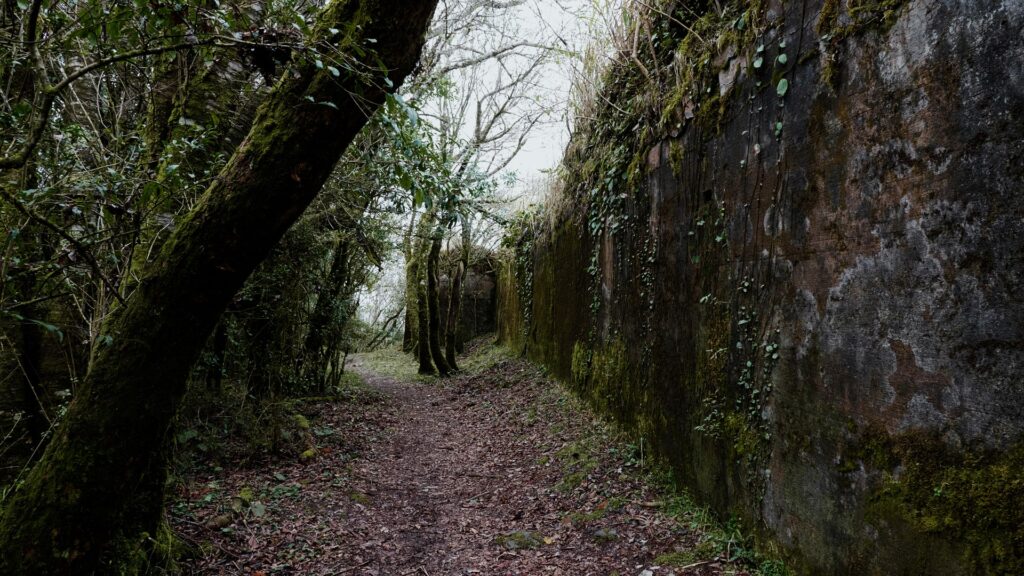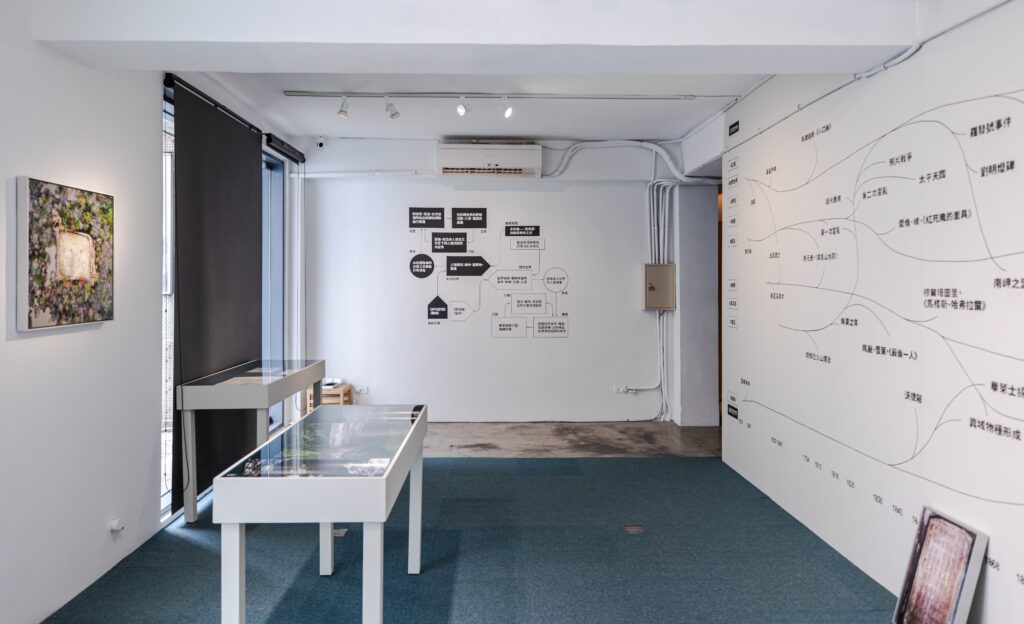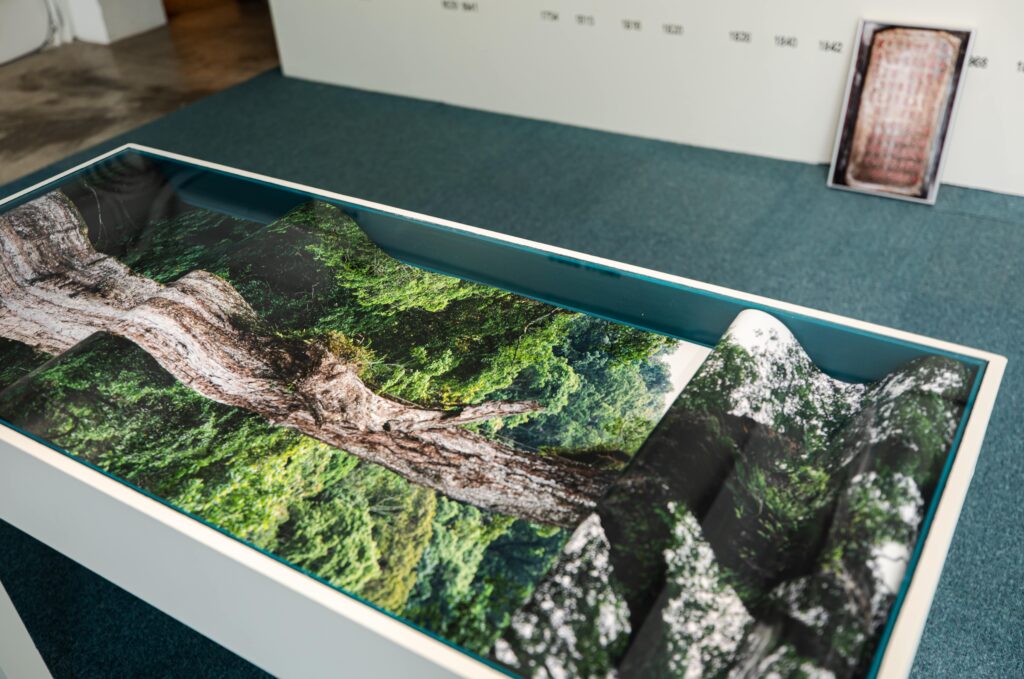Written Commission: Notes on Closed Worlds and Speculative Encounters
Yu-Chieh Li
- 2234 words, 20 minutes read
This article titled “Notes on Closed World and Speculative Encounters” is written by Yu-Chieh Li and commissioned by BLEED 2022. The article proposes some ways of thinking about speculative encounters that may shed light on approaches to the writing of global art history.

Notes on Closed Worlds and Speculative Encounters
This short article proposes some ways of thinking about speculative encounters that may shed light on approaches to the writing of global art history. In the past decades, narratives of postcolonial positions have become a core pursuit of creative practice in contemporary Asian art, and many such narratives are in dialogue with approaches of art historiography regarding temporality, locality, identity, and cultural transmission. Since this may sound like an overly ambitious claim, let us start with ‘Pailang Museum of Settler Colonialism,’ a project for Bleed, and elaborate on speculative encounters since the colonial era along two lines of thinking: first, how we might reimagine the colonial encounters to practice decolonisation and delinking; and second, how the concept of ‘closed worlds’ might inspire us to think beyond the hierarchy and limitations of geography and temporality in art historiography.
Pailang and Frontiers
Pailang Museum of Settler Colonialism, a project initiated by Taiwanese artist Wu Chi-Yu and curator Zian Chen, is an online platform that will evolve through collaborative efforts and artistic exchanges. It aims to shed new light on decolonial practices and postcolonial discourses in Asia, and to demonstrate their relevance to our present condition rather than casting colonialism as a phenomenon of the past.1 The platform will house archives of creative and academic work, including discussions, texts, and visual materials. Because its growth on Web 2.0 will depend on the engagement of its users, I will not get into the details of its visuals here.
The two Chinese characters in ‘Pailang 白浪’ translate literally as ‘white wave,’ which is a homophone for ‘bad guy’ in Minnan Taiwanese (or Hokkien), a language spoken by more than 68 percent of Taiwanese today. It is a derogatory term used by First Nations Taiwanese (most likely the Paiwan) to refer to the Hakka and Minnan (immigrants from South China since the 13th century). Some suggest that ‘Pailang’ was originally the term that Minnan people used for indigenous people, which the latter misinterpreted as self-introduction. Although the origin of the term is hard to trace, it has been passed down through oral history and is occasionally shared in online forums. The two opposing interpretations of its origins reflect the history of ethnic conflicts, and the term was borrowed as the project title to reflect on Sino-centrism as a major impediment to decolonisation of the island.
Although the project’s scope is not limited to the Chinese-speaking world, its starting point is the internal colonisation of Han-Chinese-centered and patriarchal societies in Asia. There has been an increase in research into indigenous rights and cultures through creative arts in Taiwan, though much of it has drawn upon established narratives from Canada and Australia: only recently have imperial power and Sinocentrism begun to be reflected in history and cultural studies of the Chinese speaking world, as ‘colonial power’ typically refers solely to Europe, the United States, and Japan, who seized the Qing territory since the Opium War and created a history of shame. All of this has hampered reflections on Sinocentrism. According to Emma Jinhua Teng, the Qing empire was an ‘accidental coloniser’ because the Qing had no interest in ‘recovering’ Taiwan in 1683 as officials saw no profit in an island inhabited by hostile savages.2 Chinese settler colonies in various parts of Asia have a more complicated history than English or Dutch settler colonies, as Chinese migrants frequently served as intermediaries between the Dutch East Indies and indigenous communities, rather colonising for territorial expansion.
Taiwanese literature and history scholars are well-versed in postcolonial discourses from the English-speaking world, and their approaches are broadly historical: most are critical of Han dominance in history writing, travelogues, and other visual archives that have biased perspectives about indigenous people. While many scholars are familiar with postcolonial thinkers, a few are uncomfortable with transplanting discourses about identity and hybridity. Scholar and art critic Gong Jow Jiun, who has done extensive fieldwork on grassroots community practices in Taiwan, is sceptical of the postcolonial discourses developed in Euroamerica. He claims that the modernity and postmodernity discussed in postcolonial research are not grounded in folk culture, and that this has led to an overreliance on referencing Euroamerican modernity.3 In short, Gong critiques that modern and postmodern art discourses are fundamentally antithetical to folk culture, religious culture, and local rites.4 Because it is difficult to find appropriate methods, anthropological approaches have gained favour in art historical research on modernity and contemporaneity—and thus, as Raewyn Connell notes, the North continues to produce theories while the South provides material.5 As a result, artistic research may be fruitful in identifying innovative frameworks for rethinking colonial relationships today.

Atlas of Closed Worlds
Artist Wu Chi-Yu’s (b. 1986) trajectory focuses on technological capitalism as well as human encounters and perceptions of the world. One of his most recent works, which will appear in the Pailang Museum, uses the concept of ‘closed worlds’ to reimagine encounters before colonial power seized control of the land: Atlas of the Closed Worlds (2021) includes a three-channel video installation that pairs moving images and texts by means of a programming system, transforming the material into an innovative film essay. The images were filmed during trips across Taiwan in 2020 at the start of the COVID outbreak, focusing on historical sites of colonial encounter, such as frontier guards, which were military posts established by the Japanese colonial government to control indigenous lands and exploit natural resources. Wu included footage shot from the embrasures of Li Dongshan Fortress gazing outwards, speculating about how colonisers used to exploit nature and other ethnicities.6 Another episode focused on the tallest sacred camphor tree in East Asia (located in Nantou), which is worshipped as a divine creature but also a natural resource that has been exploited since the Dutch Taiwan period: camphor trees in Taiwan were a major export, even sparking the Camphor War between the Qing and the British in 1868. They were made into gunpowder and early celluloid for film stock. Camphor deforestation is linked to the history of imperial powers and the motion picture industry, both of which exploit and objectify colonial subjects globally. Another historical conflict took place in Ljungkiaw in South Taiwan, where a war between the British army and indigenous people (Seqalu) occurred in 1867 as a result of an American merchant ship’s intrusion into indigenous territory. Each of these historical actors (Han Chinese, indigenous people, and Japanese colonial powers) lived in their own world and refused to genuinely communicate, though they were somewhat connected by maritime trade and colonial conflicts. The idea of closed worlds did not come to an end with technological advancement: even nowadays, we still live in a world where norms and ideas could exist in a vacuum. As Wu’s project points out, ‘closed’ and ‘open’ are merely relative degrees of openness (material and cultural transmission) and even strategies for narrating histories. The voice-over at the start of the moving image installation reminds us that borders are fluid. As the narratives in the video goes, in addition to physical barriers like mountains and seas, borders are where encounters happen, and their demarcation tracks progress and ideology. ‘Pathogens in the air, even language, belief, emptiness, are constantly changing the meaning of boundaries. Among them, the changes in ideology and self-identity are the most difficult to grasp.’7
In the first gallery of the Cube Project Space, two perpendicular walls present a timeline of various events that took place in open and closed worlds from 1340 onwards, beginning with the Gigantic Divine Camphor Tree and the Black Death in Europe, leading to various nodes of human and non-human encounters, such as wars, films, sci-fi texts, and other critical works, ending with COVID-19.8 The categories on the timeline’s left represent various degrees of openness and closure, whereas the horizontal represents linear time. One of the events recorded on the timeline is located between open and closed worlds: the phrase ‘Dejima was built’ marks how the Dutch-occupied Japanese port was crucial for maritime trade in 1636. The popular Nagasaki-e, which contain depictions of black slaves from Java, record such transcultural encounters that were nonetheless conditioned by strict class divisions. Cities such as Nagasaki and Batavia may be regarded as tunnels linking open and closed worlds where societies coexisted with limited interchange: Chinese traders lived outside the city walls of Dutch Batavia but also served as intermediaries between the indigenous people and the Dutch. Upper-class Sudanese were uninterested in European merchants, whereas Eurasian societies were raised by Indonesian servants and married in a small circle.9 At the same time, junks carrying Chinese and Japanese goods through Asian port cities to Europe sustained transcultural material culture. Thus, open and closed worlds constitute a more holistic picture of maritime histories; on the other hand, ‘tunnels’ such as Batavia did not always lead to the complete opening of a world that was formerly closed.

Art History and Relinking
Openness is defined not only by unregulated borders (e.g., swamps and deserts) but also by communications across time and space as well as magical powers recorded in various creative works that appear in the timeline, such as Ursula K. Le Guin’s Changing Planes (2003) and Miyazaki Hayao’s Princess Mononoke (1997), with supernatural powers unregulated by any authority.10 As closing conditions are relative and change with historical events, the artist invites us to imagine ‘closing’ as a method of elaborating on communications, borders, and conquered civilisations and heritages that were not passed down. Closedness can be a protectionist approach to reimagining terra nullius before contamination; meanwhile, there are also tunnels that have become historical players by connecting various closed worlds.
Art history is conventionally written surrounding impact, diffusion of styles, objects of genius, and movements based on available material, and thus is often biased toward cultures whose infrastructures are more developed. Yet as Thomas da Costa Kauffmann reminds us, diffusion of styles is not always formed by absorption of ‘mainstream culture’ but rather results from conflicts and negotiations among various styles.11In this sense, centers and peripheries are already intermingled in histories, instead of having a clear hierarchy. Charting encounters to go beyond ethnographic approaches and racial boundaries, art historian Piotr Piotrowski proposed horizontal art history, a concept that also goes beyond the geographic hierarchy of center and periphery.12 Each locality developed its own art history, even though it also responded to some extent to Euroamerican modernism—the point here is not to diminish the impact of Euroamerican art on others but that we have researched too little on the converse (i.e., the impact of non-Western art on the history of Western art). Piotrowski suggests that we look into how art from the margins affects the perception and criteria of art from the center. Here, Euroamerican art movements also served as points of reference for the so-called margins. In this way, Euroamerican art can be read as a closed world, which is merely a fragment until relinked with other closed worlds to form a larger bundle. George Kubler’s statement regarding object as container of temporalities is enlightening here: ‘Historically every work of art is a fragment of some larger unit, and every work of art is a bundle of components of different ages, intricately related to many other works of art, both old and new, by a network of incoming and outgoing influences.’13 In other words, the bundles of these units also store various activities at the borders that led to questions of influences. It is more crucial to explore how the messages are received than to trace certain stylistic origins. Each closed world can be seen as instrumental in demarcating nodes of specific time and space, helping us to form meaningful bundles of material culture.
As ‘closed worlds’ are not absolute, we can by no means trace the visual record of the first authentic encounter, and thus should abandon the concept of ‘origin.’ Pailang Museum will not superficially house objects linked by their visual characteristics. Instead, it can speculatively narrate the bricks that are missing from the encounter, creating tunnels for rethinking borders and relinking the closed worlds in art history.
- Renowned subaltern thinker Gayatri Spivak warns that postcolonial discourses bear the potential of casting colonial violence in the past. Gayatri Spivak, A Critique of Postcolonial Reason: Toward a History of the Vanishing Present (Cambridge, MA: Harvard University Press, 1999), 1.[↩]
- Emma Jinhua Teng, Taiwan’s Imagined Geography: Chinese Colonial Travel Writing and Pictures, 1683–1895 (Cambridge, MA: Harvard University Press, 2006), 81.[↩]
- Gong Jow Jiun, Kau-Puê Aesthetics: Near Future Deity in Contemporary Arts (Taipei: Locus Publishing, 2022), 7.[↩]
- Ibid., 222.[↩]
- Raewyn Connell, Southern Theory: The Global Dynamics of Knowledge in Social Science (London and New York: Routledge 2007).[↩]
- The fortress is situated at the border of Xinzhu and Taoyuan counties.[↩]
- The author’s own translation.[↩]
- See the exhibition website, accessed 31 July 2022, https://thecubespace.com/online-show-zh/atlas-of-the-closed-worlds/[↩]
- See Jean Gelman Taylor, The Social World of Batavia: European and Eurasian in Dutch Asia (Madison: University of Wisconsin Press, 2nd edition, 2009).[↩]
- Here, the artist referenced Paul N. Edwards, The Closed World: Computers and the Politics of Discourse in Cold War America (Cambridge, MA: The MIT Press, 1996).[↩]
- Thomas DaCosta Kaufmann, Toward a Geography of Art (Chicago: University of Chicago Press, 2004). [↩]
- Piotr Piotrowski, Art and Democracy in Post-Communist Europe (London: Reaktion Books, 2012), 31.[↩]
- George Kubler, ‘Style and Representation,’ Annals of the New York Academy of Sciences, Vol. 138, no. 2 (Feb 1967): 849-50.[↩]
- Writer - Yu-Chieh Li
- Notes on Closed Worlds and Speculative Encounters is commissioned by Museum of Contemporary Art, Taipei as part of BLEED 2022.
BLEED (Biennial Live Event in the Everyday Digital) was conceived by Campbelltown City Council through Campbelltown Arts Centre, and the City of Melbourne through Arts House. BLEED 2022 is produced and presented by Campbelltown City Council through Campbelltown Arts Centre, and the City of Melbourne through Arts House, Taipei Performing Arts Center and Museum of Contemporary Art, Taipei. BLEED has been supported by the Taiwan Ministry of Culture and Cultural Division, Taipei Economic and Cultural Office in Sydney.